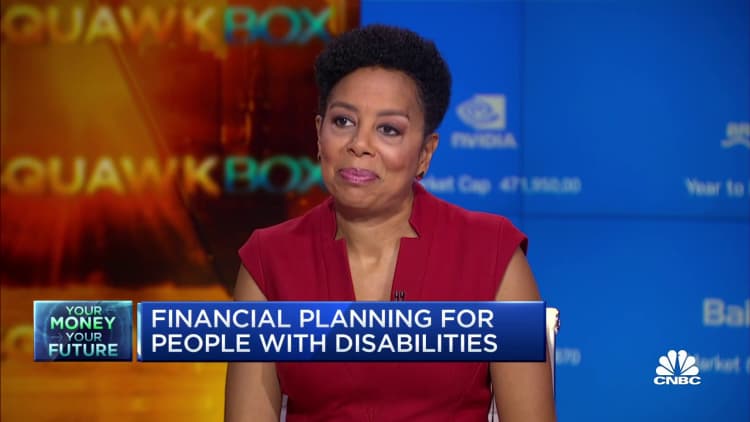How to financially plan for a disabled loved one’s future care

Daniel Trush was just 12 years old when a brain aneurysm changed the course of his entire life.
“I went into a coma, and I was in the coma for 30 days — and I was in the hospital and rehab for a total of 341 days,” said Daniel, who is now 38 and lives in New York. But, he quipped with a smile, “who counts?”
During his rehabilitation, Daniel and his family found a connection to others through music. He is now the co-founder and president of Daniel’s Music Foundation, a non-profit organization that provides free music programs for people with disabilities.
Daniel’s parents, Ken and Nancy, now in their 60s, helped him achieve his goals by planning his financial security with an entrepreneurial mindset.
“I’m used to business plans, so I turned a business plan into a personal plan,” said Ken Trush. “That’s what we get. That’s what we want to do. Where’s the surplus? How much do we have to save?”
According to the Centers for Disease Control and Prevention, approximately 61 million adults, or one in four, live with a disability. A new study by Fidelity found that more than half of carers of loved ones with disabilities had little time to prepare before taking on responsibilities.
Daniel Trush, President of the Daniel’s Music Foundation in New York.
Daniel’s Music Foundation
Still, about a third of respondents said it was easier than expected to plan for current and future spending and to understand the government benefits available.
Access all available benefits
One of the most important steps in caring for a child or beneficiary with disabilities is applying for supplemental income or Social Security disability insurance, said James Lange, president of Lange Financial Group in Pittsburgh. You can apply online at the Social Security Administration website.
“Also, maximize your employee benefits and look at what state benefits are available to you at your city, county, state and federal levels,” said Jessica Tuman, vice president of the Voya Cares Center of Excellence at Voya Financial in Atlanta.
Benefits may include healthcare concierge services focused on helping families care for loved ones with complex, chronic or ongoing care needs, she said. Your company’s programs may also offer legal services to assist you with your child’s medical clearance forms, will, power of attorney, and other estate planning documents.
Set up targeted savings
Boonchai Wedmakawand | moment | Getty Images
Experts say that establishing targeted savings is also crucial to safeguarding a disabled person’s financial future.
With an ABLE account, families can save up to $16,000 a year without impacting state benefits for someone who became disabled before the age of 26.
“If you saved into a regular 529 plan and your child became disabled 26 years ago, you can transfer those funds into an ABLE account,” said financial advisor Charlie Massimo, senior vice president of Wealth Enhancement Group in Deer Park, New York . “However, there are certain caveats and restrictions that you must follow.”
One of the best ways to get support is to search for nonprofit organizations for your specific type of disability.
Jessica Tumann
Vice President of the Voya Cares Center of Excellence at Voya Financial
Optimizing Roth’s individual retirement account conversions can also be “beneficial for you, but crucial for your child,” Lange said. When a disabled child or beneficiary inherits a traditional or Roth IRA or 401(k), they can extend the distributions over their lifetime, rather than having to withdraw funds within 10 years like most beneficiaries.
For example, if a disabled child inherits a regular IRA, they could extend it throughout their life but would have to pay taxes on the annual distributions, he said. However, converting the inherited IRA to an Inherited Roth IRA – and paying taxes on the conversion – would allow the disabled beneficiary to receive tax-free distributions for life.
Truman recommends that families seeking financial or legal advice regarding the formation of a special needs trust or other aspects of estate planning contact the Academy of Special Needs Planners and the Special Needs Alliance to find experts.
Find a community of support
Dougal Water | digital vision | Getty Images
Connecting with other families with dependents with disabilities is another way to learn about financial and other resources that may be available in your area.
“One of the best ways to get support is to find nonprofit organizations for your specific type of disability,” Tuman said. Look to groups like the National Down Syndrome Association, the Autism Society and Easterseals, which may have specialized programs that provide recreational care and/or parenting support programs, she said.
Getting together for music and fun can also lead to important financial talks — and connections. “We find that a lot of parent caregivers come together because there is a commonality,” said Ken Trush. “They feel comfortable.
“Sometimes outsiders don’t understand what they’re going through.”
September is Brain Aneurysm Awareness Month. Daniel Trush and Sharon Epperson are brain aneurysm survivors. You can learn more about the risk factors and treatment of this disease on the website Brain Aneurysm Foundation Website.